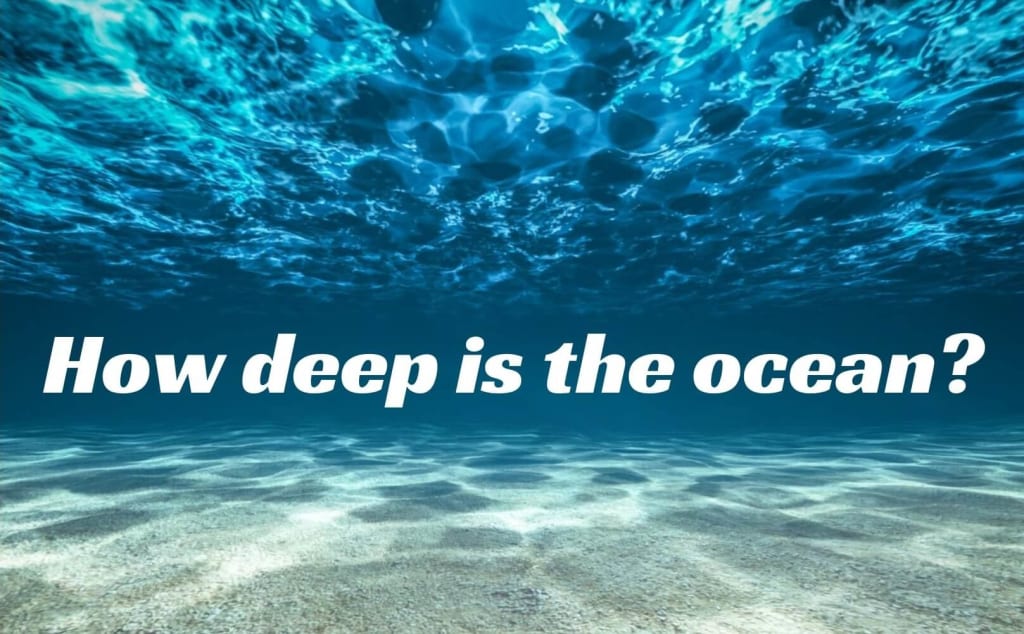
The ocean is way deeper than you think.
The ocean is a lot deeper than you think. It goes much deeper than what most people realize. If you shaved off all of the land from the tops of every continent and island in the world and filled up the ocean's deepest points with that land, then there would be an entire planet underwater. Three fourths of our planet is already underwater though, so it's really deep.
When looking at the size of things, it's important to understand that dots are, on average, the size of humans. Larger dots represent larger objects, like elephants. And the largest object ever built is the Knock Nevis, which is %size% meters long. But it's important to remember that these measurements are approximate- even under water things are never just one single dot. The first milestone is at %depth% meters below the surface- which is the maximum depth allowed for recreational scuba diving. A little further down at %depth2% meters is where the wreck of the Lusitania was discovered- which is interesting because the Lusitania itself is 240 meters long, meaning that it sank in water shallower than it is long. Just slightly deeper than that at 100 meters is where diving can become seriously fatal if you're not careful because of decompression sickness.
Herbert Nitsch set the free diving world record at 214 meters, diving with a single breath. Ahmed Gabr holds the scuba diving world record at 332 meters, just shy of the Empire State Building's height submerged underwater. The maximum dive depth for Blue Whales and US Seawolf Class Nuclear Submarines is 500 meters. Emperor Penguins reach a depth of 535 meters, highlighting the intense water pressure at such depths.
At a depth of 535 meters, the water pressure is so intense that it's roughly equivalent to the weight of a polar bear standing on a quarter. This illustrates the immense force exerted by the water at such depths. Going deeper to 830 meters, the pressure increases further, reaching the height of the Burj Khalifa, the world's tallest building in Dubai. The pressure here is substantial, creating an environment where only specialized submersibles can withstand the conditions.
However, the truly daunting zone begins at 1,000 meters below the surface. At this depth, natural light from the surface can no longer penetrate, plunging the environment into permanent darkness. Simultaneously, the water pressure at this level is comparable to the atmospheric pressure on the surface of Venus, a planet known for its extreme conditions. At this point, the pressure is so severe that any human attempting to venture without specialized equipment would face rapid and fatal consequences. The extreme darkness and crushing pressure make the depths beyond 1,000 meters a mysterious and perilous realm in the ocean.
If the water pressure didn't pose a deadly threat, encountering the Giant Squid would occur at this sea level. Moving to 1,280 meters, we reach the maximum depth dived by the Leatherback Sea Turtle. Descending further to 1,828 meters would bring us to the deepest part of the Grand Canyon if it were submerged underwater.
At 2,000 meters, encounters with more terrifying sea creatures begin, such as the ominously named Black Dragonfish—a carnivorous beast with a stomach that prevents light emission. In total darkness at this depth, the only way to see this creature is with a flashlight.
Continuing down to 2,250 meters, we would reach the maximum depth dived by both Sperm Whales and the formidable Colossal Squid. Sperm Whales often bear sucker marks and scars from battles with the Colossal Squid, suggesting intense encounters at these incredible depths. The squids themselves can grow to be 14 meters long, weigh up to 750 kilograms, and boast eyes the size of a dinner plate, along with razor-sharp sickles in the middle of their tentacles.
Venturing to these extreme ocean depths demands more than luck. Descending to 3,800 meters leads to the discovery of the RMS Titanic wreck. A bit deeper, at 4,000 meters, marks the entry into the Abyssal Zone, where water pressure reaches an astonishing 11,000 pounds per square inch. In these dark realms, peculiar and almost alien-like creatures dwell, including the Fangtooth, Angler Fish, and Viper Fish.
At 4,267 meters lies the average ocean depth, but certain areas plunge even deeper. The wreckage of the battleship Bismarck rests at 4,791 meters, a reminder of World War II's depths. Reaching 6,000 meters heralds the beginning of the Hadal Zone, named after the underworld Hades. The pressure here, 1,100 times that at the surface, equals an elephant balancing on a postage stamp or a person bearing the weight of 50 Boeing 747 jumbo jets. Without protection, one would be instantly crushed, yet life persists in strange forms.
The DSV Alvin's maximum depth is at 6,500 meters, aiding in the discovery of the Titanic. Plunging to 8,848 meters aligns with the height of Mt. Everest if inverted and submerged. Further down, at 10,898 meters, James Cameron reached during the Deep Sea Challenger Mission. However, the deepest point humans reached dates back to 1960, when Don Walsh and Jacques Piccard, aboard the Trieste submarine, descended to 10,916 meters. At 10,972 meters, akin to a commercial airliner's average flight altitude, we gain a perspective of the ocean's abyss. The Challenger Deep, at 10,994 meters, represents the known ocean floor bottom, southwest of Guam Island. Yet, undiscovered depths likely exist, with the Sirena Deep, found in 1997 at 10,732 meters, being the second deepest known point. With only 5% of the ocean floor mapped, the remaining 95% remains a mystery, leaving open the possibility of uncovering even deeper ocean realms in the future.
About the Creator
Enjoyed the story? Support the Creator.
Subscribe for free to receive all their stories in your feed. You could also pledge your support or give them a one-off tip, letting them know you appreciate their work.






Comments
Ami is not accepting comments at the moment
Want to show your support? Send them a one-off tip.